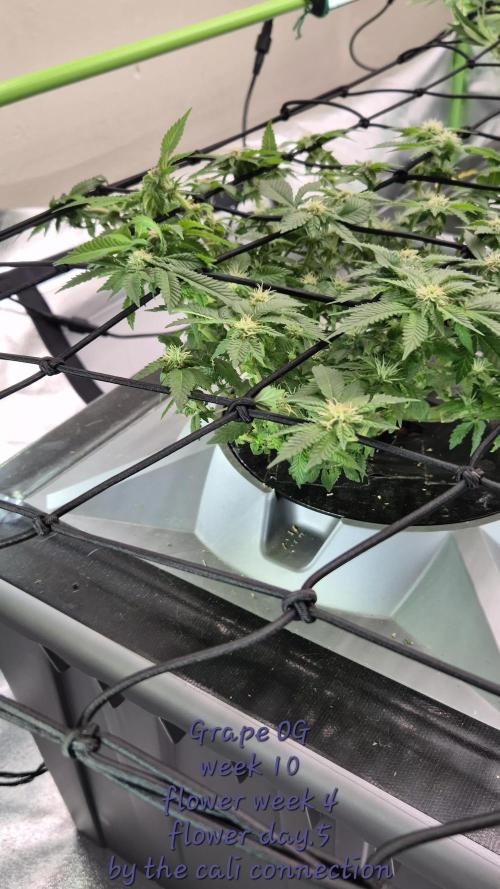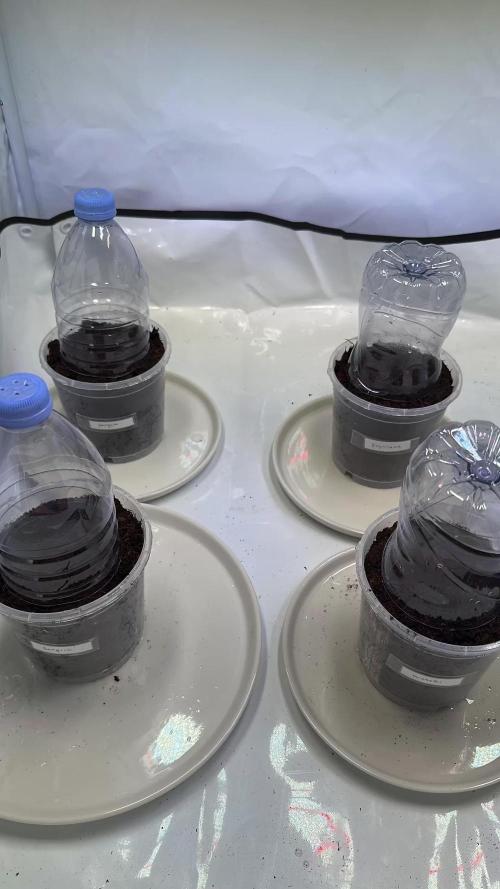The Grow Awards 2026 🏆 































Likes
Comments
Share


@GermGrowFox
Follow
19. April
Der Spargel wird stabiler. Wächst allerdings alles immer noch sehr langsam, ist allerdings auch nachts noch ein bisschen kalt.
Das nüchtern sein fühlt sich bis auf weiteres sehr undankbar an. Aber aus dem anstrengenden Part bin ich mittlerweile raus. Schlaf funktioniert Ei igermaßen wieder, Gedanken im kopf sausen allerdings wieder sehr viele. Habe gefühlt immer noch ein großes Loch in mir, das ich nicht weiß mit was ich es nun füllen soll. Updates folgen, geht allerdings langsam bergauf.
Likes
25
Share


@Organic_G
Follow
Hab die Babys unter ein Netz gespannt, ggf. Waren die noch zu klein dafür…
Scheint wohl so als wenn dich Wachtszumsphase noch etwas dauern wird.
Habe mir einen Humidifyer und ein Heater von AC Infinity bestellt um den VPD korrekt aufrecht erhalten zu können, es fehlen sowieso noch einige Grad C für ein vernünftiges Wachstum.
Neben an die 🍄
Likes
15
Share


@OrganikTek
Follow
Good weather is Back.
Gave them some epson salt to bring black cream colours out.
Black Cream is now turning red and fatning buds. Shes yellowing dont now if its light stress(her lst is 27/28 and ppfd about 600 and i event gave her so much CO2 now) colors changing or senescense.
Bomberry think shes reduce grow rate abd dont know why.
Wedding cake Jumped and its taking over the scrog net
Couskush growing good some wilting caused by fan. Shes the smallest and at her hight her LST its on the lower edge.
Chears BrotherHood
Likes
9
Share


@RBG
Follow
Week 10
Flower week 4
Flower-day 1
05/11/2025
Nutrients change
Floramax veg1
Floramax Organabud
Floramax flowering enhancer
Floramax Rezin
Cyco platinum series silica
Green planet bud booster
Complete grow cal mag
( sensi unfortunately got refunded so got this instead today )
Sleeps with the fishez ( hocI )
Ladies are looking good overall, let the fun goodness begin i guess 😂
7/11/25
Blockage within systems finally fixed after 4 flushes. Not exactly sure what it was but whatever ive done has fixed it for now 🤷♂️😂 take it as a win for now i guess
11/11/25
Unfortunately I hate scrogg so took it off but once I had spread her out again with lst, I noticed that shes struggling with lower growth. I saw this with my autoflowers. I'm not too sure if its from too many budspots,colas or if it's just from being overpacked. So her pisitils showed up on the 25th, some people count from that date as flower and some count as soon as you flip, I've decided to go of the 25th as first pisitils so its only 3 n a half weeks currently.
I decided to take a few branches and a few of the lower budspots to try and help her even herself on where shes taking her sugars and growth.
No Defoilation, just 10 or so budspots n only 3 branches. I DONT NOT RECOMMEND doing any of this, I'm only reattempting this because it worked on autos I had going. I do think I've made the right choice
Grape og is meant to be a pretty hearty and forgiving strain, so she should bounce back pretty quickly
Oh well. I'll definitely be rerunning her again later in future but trying a different method
Likes
9
Share


@Mo_Powers
Follow
it has really developed very well. it has grown another 20cm. and the flowers are now really coming into their own and are getting thicker and thicker. because of the heat, it has been given calm-a-mag and acti-vera by biobizz. and of course now also bio-bloom.
Likes
3
Share


@Rko41
Follow
A l’origine acheter en auto mais il y a du avoir un bug du breeder passer 2 mois j’ai compris que c’était une féminiser classique en tous cas début de Flo enfin sachant que je l’avais lancé que mi mai
Likes
12
Share


@Ozeola
Follow
It’s been a good week of bud growth. I started turning up the dial to 400watts over night when the temps start to lower. I did add an hps to add color and wattage to the grow and not break the bank. So far it’s paying off. With allot of heat I’m keeping my eye on the water levels. Refilling as needed.
Likes
1
Share


@Skull
Follow
Not to bad a week growth is sure slower in Coco as opposed to Dwc may be not feeding correctly
Likes
16
Share


@HAPPY91
Follow
Mars Hydro TS 3000
Dimensions:
25.3" x 22.8" x 2.7"
Weight:
11.3lb
Coverage:
4x4 feet
Watts Consumed:
~450w
Light Intensity:
Up to 1150 uMol @ 18" height
Spectrum:
Full White + Infrared
LED Brand:
Unbranded LEDs
Voltage:
120; 240; 277
Warranty:
3 Years
Week 1 3/24/2021-3/30/2021:
Day 1 3/24:
Played Hip Hop Radio. 71.1-75.7 55%-74%
Day 2 3/25:
Played Hip Hop Radio. 75.6-78.6 45%-56%
Day 3 3/26:
Played Reggae Radio. 75.0-79.5 53%-60%
Day 4 3/27:
Played Hip Hop Radio. Mixed 2 ml Fish Brew to 1 gallon water=38 ppm 6.7 ph 68 f. only drank 0.25 gallons. 75.6-81.0 42%-55%
Day 5 3/28:
Played Eminem Radio. 66.0-80.1 48%-67%
Day 6 3/29:
Played Jimmy Hendrix Radio. 65.5-79.2 44%-77%
Day 7 3/30:
Played Cardi B Radio. Topped above third inter-node then defoliated all lower growth to focus on Main-Lining. Drank 0.25 gallons plain water=25 ppm 6.4 ph 69 f. 65.3-80.1 44%-77%
Final Weekly Notes:
So far so good no complains or worries. Very excited to have this amazing grow with such amazing products. Big thanks again to Coast Of Maine, Exotic Seed, Fish Brew, and Mars Hydro for this amazing experience. The Mars Hydro is very powerful I had to turn it down because I noticed a little light burn when I had it at 50% 24 inches away down 25% 24 inches away. Feel free to leave a like comment question or even give that follow button a tickle. I am always learning something new everyday. Thank you so much for stopping by and checking out my grows. Good luck stay safe happy growing cheers!!!!
Likes
2
Share


@Meisenberg
Follow
Buds stacking up nicely. Did some overdue trimming/defoliation to help with light and airflow. They are some thirsty girls. Looks like I've got all 3 phenotypes of this strain represented: short and bushy, thin and wispy, and Original Recipe. I'm not sure which is which. Meh. I'm optimistic regardless.
Likes
4
Share


@JardineiroBr
Follow
Essa semana choveu e vestiu muito mas deu tudo certo, fiz o LST nas duas para ter mais botões
Likes
12
Share


@TgOgFaRms
Follow
I recently had the opportunity to grow the Toof Decay x Walter White strain from Mephisto Genetics, and it was my first experience with this particular strain. While I'm still in the process of forming a solid opinion, I can share my initial observations.
The bud structure of this hybrid strain didn't feel as dense as I had hoped during the trimming process. 😕 However, I was impressed by the beautiful purple hues displayed by the buds. The colors were certainly visually appealing. 💜
Although I haven't had the chance to test it yet, I'm eagerly looking forward to experiencing the effects of Toof Decay x Walter White. 🌬️💨 At this point, I would rate it a 7.5 out of 10.
As my journey with this strain continues, I'm excited to see how it develops and how its effects unfold. Stay tuned for more updates! 🌱🔜
Happy growing and exploring new strains! 🌿✨
Likes
5
Share


@Ninjabuds
Follow
It’s the 1st week of flower I flipped the plants to 12/12 a few days ago. There is a lot going on and a lot of cool and amazing things coming in the near future. Make sure to check out my YouTube page. I bought me a DJI gimbal this week. Might be my new favorite toy. The temps are starting to break for the summer. I don’t see it being very long until winter is here and it’s time to use a heater and not an ac unit. All of the plants are healthy. The plants have all grown so well I turned down the light intensity a bit today the plants didn’t seem like they was starting to strech very much. Hopefully the lower light intensity will make them strech out just a bit
Likes
2
Share


@Cannabot
Follow
if you love blueberry then this strain is for u,absolute nug fest.Nice colas.wasnt the tallest plant but short and stocky with decent meat on the bones.Very resistant
Likes
37
Share


@J4kpvp
Follow
Hello:)
The wasabi is ready now, trichomes are about 10%amber, the front right sangria is surprisingly also at about that ripeness. The two sangrias in the back look very cloudy, but almost no amber, so i think one more week is the right call.
I‘m also having some humidity problems… lets hope there won‘t be mold in the big buds afterwards… there is one bud on the wasabi that already doesn't look super good… that‘s the only thing that could still mess up my grow…
Also here is also the video so far:) lets hope the next update is the harvest:)
Likes
27
Share


@w33dhawk
Follow
04.08.21 gibt nicht viel zu sagen die bilder sagen mal wieder alles.......... bis zu diesem Zeitpunkt läuft immer alles ok und dann kommt mein Problem wie in jedem grow immer ab der 2ten woche der blüte ich werd wahnsinnig ich bekomm das noch irgendwann in den Griff hoffe ich zumindest hab mich für diesen grow damit abgefunden das ich wieder ein Problem habe denke mal das ich den vegi Dünger zur blüte Umleitung unter dosiert habe und jetzt mit vegi ausgleichen is glaub ich eher kontra produktiv werde mit etwas mehr blüte dünger nochmal versuchen die Pflanzen wieder etwas vitaler von der Farbe her zu bekommen aber ich glaube das wird nix mehr. Hab mir aber für die nächste Runde Gedanken gemacht und werde auf Light mix umsteigen damit ich mehr gefühl für das düngen bekomme da ich dort dauerhaft düngen kann und werde wohl auch den Dünger auswechseln,entweder alte schule mit guanokalong oder powder feeding von greenhouse seeds bin mir da noch nicht sicher muss mich mehr informieren über die Handhabung beider Dünger



























